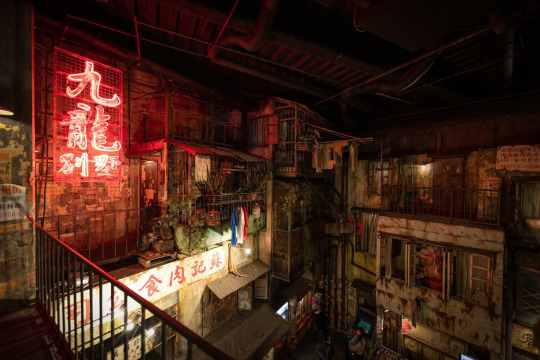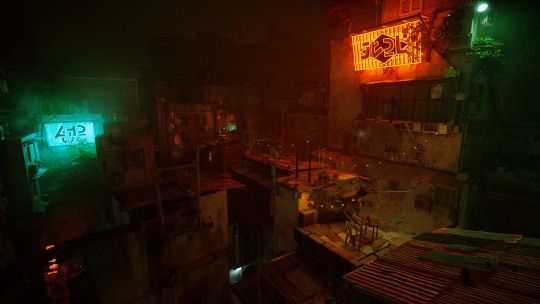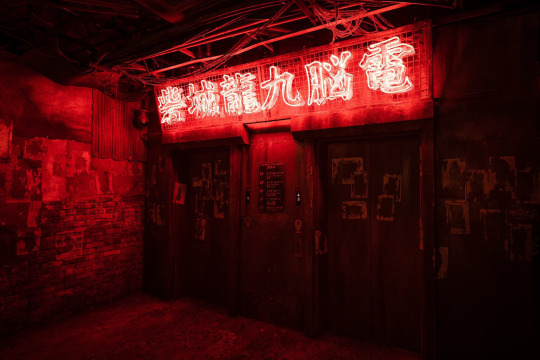#cyber kowloon walled city
Explore tagged Tumblr posts
Text








Four of those pictures are stills from the game Stray.
Four of those are photos taken by this Toshibo. "Photos from the old days of Warehouse Kawasaki, also known as Cyber Kowloon Walled City."
( website twitter instagram )
I don't know. I just thought it was cool.
Also please give me a Stray open world.
9 notes
·
View notes
Text
Kowloon District
//Today I bring some lore about Kowloon District, the place where Rose and the gang live (with some help and inspiration from @unforgettable-garbage1997)
- Kowloon District is right on the west edge of Cyber City, bordering the Trash Zone. It’s made up of skyscrapers so tightly-packed they’re clipping into each other, the physics broken just right so that they keep each other in place rather than all launching into the air. This mostly doesn’t affect the living experience too much, though inhabitants need to be careful putting anything on or too close to any clipping wall. As a result, apartments at the sides of buildings are the cheapest.
- Apartments with a window tend to be the most expensive, even if the view tends to be nothing more than darkness and an overwhelming number of advertisements. Windows are often also used for disposing of trash, with the other most popular method being leaving it on the roof.
- The district itself is a pit of anarcho-capitalism, ruled over by a crime syndicate. As a result the district is unregulated and rife with crime, with many businesses ran by rules that would get them closed down anywhere else in the city. Attempts to do anything about this have been abandoned, as no Ambyu-lances that were sent in made it back out.
- Wealthier residents can pay for protection from the syndicate. The price of this increases with their earnings, never leaving them with much money to spare. More often than not, more money is spent on this protection than the rent.
- This area is mostly inhabited by failing Addisons, with this being the last place they can afford to go other than the Trash Zone itself. The adspace is ridiculously overcrowded due to the sheer volume of Addisons living in a relatively small area. Flocks often share adspace, investing in one larger ad that has a slight chance of being seen than multiple tiny ones.
- Many Addisons run their businesses from their apartments despite the limited space. A separate shop is another luxury that only the wealthier residents can afford.
- While the vast majority of Addisons in Kowloon District live there because they have no other place to go, there are a handful of more shady, successful ones that moved there specifically to take advantage of the lack of regulations. To them, the risks of living there are worth the ability to do anything with their business with no legal consequences.
- While it’s not completely unheard of for Addisons to make it out of Kowloon District and find success in the inner city, it’s incredibly rare. Due to the nature of the place and the syndicate’s prices, any progress is often an illusion and the district’s inhabitants are stuck in a cycle of barely getting by.
#low standards low prices (addisons)#//worldbuilding#//don't have a tag for it for now but maybe will come up with one later#//long post
6 notes
·
View notes
Photo

Farewell to Warehouse Kawasaki: Japans Cyber Kowloon Walled City
Farewell to Warehouse Kawasaki: Japans Cyber Kowloon Walled City http://bit.ly/355jERi
0 notes
Video
youtube
💕✨ BRAND NEW JAPAN VLOG IS OUT ✨💕
DAY 10- ANATA NO WAREHOUSE & THE LOCKUP RESTAURANT~!! ♡ 🌴💕
💕✨https://www.youtube.com/watch?v=CVhHPov4YBI ✨💕
In this video we travel 40 minutes from Tokyo to take a visit in Kawasaki to go to "Anata no Warehouse"!! It's a amazing run-down Arcade that is designed after "Hong Kong’s Kowloon Walled City" It is like Biohazered, Resident evil, dystopian, Silent hill, cyber punk style ARCADE!! It's actually amazing!♪ I wish I could of shown you more of it! Then to continue the creepy scary day we go to Shinjuku to "The Lockup" Restaurant Which is a Prison jail house style Restaurant!! Inside you get handcuff and taken to your cell in the Prison where police ladies and jail house inmates come and serve you the themed food!! ngl.... it was some of the most tastiest food we had!!♪! oh... and... there's a scary show whilst you eat... xD ^-^ Enjoy~~♪
Don't forget to give the video a thumbs up and a share~!! ♡ Abi pop x♡x
REBLOG IF YOU ARE EXCITED FOR MORE 🌸💕
#abipop#abipop in japan#japan vlog#japan#tokyo#kawasaki#shinjuku#creepy#spooky#arcade#jail#jail restaurant#prison restaurant#cute#kawaii#abi pop#kelsey ellison#nanoade#hiprain#anata no warehouse#the lockup#lock up shinjuku#japanese fashion#aymmy#spooky foods
41 notes
·
View notes
Photo

Farewell to Warehouse Kawasaki: Japans Cyber Kowloon Walled City
Farewell to Warehouse Kawasaki: Japans Cyber Kowloon Walled City http://bit.ly/355jERi
0 notes